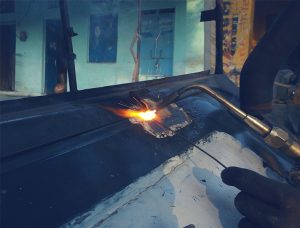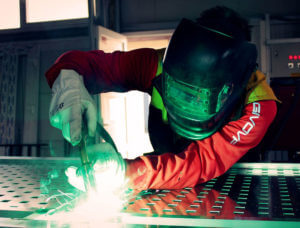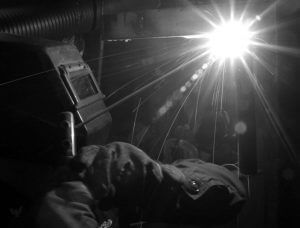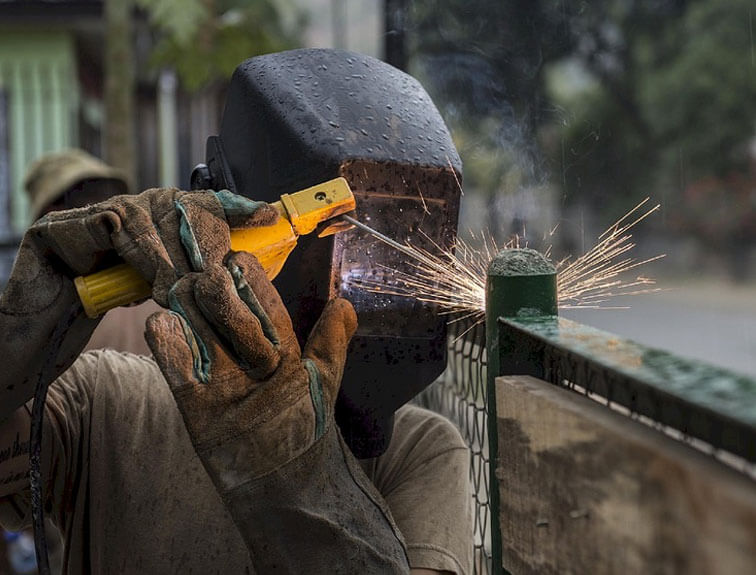Welding
Helpful Information About Potential Welding Careers
-

Promising Career Opportunities for Welding Training Graduates
Have you ever dreamed of working for NASA or navigating the ocean floor? A career in welding might just give you the opportunity you’re looking for! Keep reading to learn interesting facts about professional welders.A Variety of Career Paths to Choose From
Welders have the opportunity to choose from a variety of career options. Many welders choose to work in manufacturing or construction. However, professional welders have the chance to work in Underwater Welding, robotics, military support, NASCAR, or NASA. Whether you have a passion for high speed racing or desire to working alongside the military, there is a career in welding for you.Opportunities to Travel
One of the greatest perks of welding is the opportunity to travel to places you may have never been before. Professional welders may work to repair cruise ships or pipe lines, allowing for extended time out at sea and along different coast lines. Additionally, if a welder chooses to work in motor sports, the welder will travel with the pit crew, and have the chance to visit to racetracks in major cities around the country. Lastly, with underwater welding, professional welders have the ability to explore the ocean floor.Welders are in High Demand
The average age of welders is nearly 55 years old. This means that many welders will begin retiring in the next decade or so, opening up many positions for aspiring welders. Additionally, welding techniques are similar amongst most professionals which makes welders very versatile giving them the ability to switch between professions easily. This makes professional welders a hot commodity to employers. According to the Bureau of Labor Statistics, California has the second highest level of employment of welders. This mean that job prospects for welding training graduates looks promising!Short, Affordable Welder Training Programs
A 4-year college degree is not required to become a professional welder. If continued education does not suit your lifestyle, welder training programs may be perfect for you! Advanced Career Institute offers hands-on Welding Training Courses at three California campuses located in Merced, Fresno and Visalia. Welding Training takes anywhere from 24-38 weeks to complete. With the help of ACI, you will be on your way to beginning your new welding career in no time! To learn more about becoming a professional welder, head over to our California Welding Training Page! -

Everything You Need to Know About Underwater Welding
Underwater welding is a dangerous career yet it employs numerous people. Why is this so? Read on to learn more about the pros and cons of underwater welding.What is Underwater Welding & How Does It Work?
Underwater welding has been around since 1932, and is often referred to as hyperbaric welding. It can take place in wet or dry environments. Wet welding is when the welder is entirely submerged in water. The welding is executed using forms of arc welding that employ a waterproof electrode where the welding supply connects to equipment through cables and hoses. Conversely, dry welding is used for high integrity welds. During dry welding, the weld is completed within a sealed pressure chamber that prevents water from entering the work area. They often use a form of gas tungsten arc welding. Dry welding is often used to repair pipelines and ships. Underwater welding research is being conducted at depths of up to 3,300 feet.Why is it dangerous?
My guess is that your first thought about underwater welding was “Electricity and water aren’t a good mix. Isn’t that dangerous?” The answer is…yes! However, many safety precautions are taken to reduce the risk. Underwater welding is completed using a welding stick where a layer of bubbles is created to shield the weld from water. Dry welding is also a safer method since the weld itself is not exposed to water. However, electricity does not pose the biggest threat. Welders operate at high pressures that threaten the body. Additionally, large bubbles created by the weld and the overall dark atmosphere underwater makes it hard to see, and is threatening to the welder. The most notable underwater risk is differential pressure or Delta P. In Delta P, water from one area attempts to rush to fill another. The pressure difference accumulates hundreds of pounds which can draw divers in and make it very hard to escape. Although there is a high risk of Delta P, companies have come up with action plans on how to avoid this fatal occurrence. For more information on Delta P, check out this video.Why do people choose to take these risks?
Many welders choose this career path because it is exciting, peculiar and challenging. Additionally, underwater welders are essential components to industries all over the world. This means that skilled welders are in high demand. Currently, companies do not possess the technology to complete underwater welding tasks without humans. This provides underwater welders with job security. On top of it all, underwater welders have the opportunity to make significant salaries that they would not have access to as a typical welder.The Future of Underwater Welding
According to the Bureau of Labor Statistics, the average salary for an underwater welder is around $53,990 per year or $25.96 per hour. Underwater welder jobs are concentrated in California, Florida, Michigan and Washington. Your career can take place in one of two locations: inland or offshore. Inland welders typically make less than their offshore colleagues. They tend to work on bridges, dams and small water vessels. Although there is less pay involved, you operate on a less demanding schedule (40-hour work weeks) and less travel is required. However, offshore welders tend to bring in the big bucks. They work on oil rigs and large ships. In this job, you may spend a significant time out at sea and can expect to long work weeks, even up to 80 hours! Interested in becoming an underwater welder? The first step is to get your welding certification. Advanced Career Institute offers hands-on welder training in the California area. ACI welding campuses are located in Visalia and Fresno. For more information, head over to Welder Training! -

How to Make Your Welder Resume Stand Out
Entry level welders have to figure out a way to make their resume stand out from the rest of the pack. The question is how to make your resume catch the eye of a recruiter and land an interview. The answer depends on the employer, but there are some common themes amongst the most successful entry level welding resumes.Recognize What Welding Employers are Looking For
The best welding candidates are able to read and understand sketches and diagrams to determine the exact materials and operations needed for each welding project. It is not enough to know how to properly set up and maintain welding equipment. The candidate should know how to use an array of semi-automatic and manual welding tools. A candidate with additional skills, talents and knowledge will have a competitive edge. An example is the ability to use metal shaping machines or flame-cutting equipment. Let's take a look at some helpful resume tips for entry level welders.Highlight Your Skills on Your Welder Resume
Use your welder resume to highlight the skills you are good at. If you understand the ins and outs of pipeline construction, structured fabrication, brazing, soldering, shop mathematics or blueprint interpretation, put it “above the fold” of your resume. This means your key skills should be listed in the upper half of your resume so they grab the attention of the recruiter.Show Why You Are Better Than Other Candidates
Your resume will receive minimal attention unless you find a way to differentiate yourself from the competition. You can differentiate yourself either through the design or the way you talk about your skills and experiences. Try to avoid using a standard resume template you find online. Furthermore, using the same words and phrases as other entry level welding candidates will not separate you from the pack. Be as original and creative as possible without coming off as overly eccentric. Highlight your skills, certifications and relevant employment history in an artful manner and you will eventually land an interview.Tailor Your Welder Resume for the Open Position
The entire purpose of your resume is to express why you are a solid match for the open position. Cater each resume to the job description of the position you are applying for and you will increase the odds of getting an interview.Include Relevant Non-Welding Certifications
Non-welding certifications should be highlighted as long as they are relevant to the position's responsibilities. Examples of relevant certifications include OSHA training, first aid and certified rigger. Looking for more welder resume tips? Contact our job placement office today to set up a meeting and get personalized guidance! Open to all ACI students and graduates. -

How Welders Can Take Care of Themselves
People may not believe it, but welding is a unique art form. Along with producing the welds and beads comes stress and frustration. The wrong material or the fluctuation of an arc can make a weld look knotty and somewhat sloppy. Many welders try extremely hard to produce smooth, even looking welds. The stress they experience during the performance of their job takes many forms. There are several welding stress relief mechanisms that are both effective and simple.Maintaining the Same Position for a Long Period of Time
When completing a long bead, holding the same position can cause muscles to become tight and sore. In between welds, take a few minutes to stretch. Reaching toward the ceiling stretches the arms, legs, and back. Hand exercises will keep the fingers and wrist flexible. Stretching improves blood flow and keeps a person alert and focused.Intense Concentration While Completing a Difficult Weld
Having to maintain strict focus for long periods of time can lead to headaches and eyestrain. Once every couple of hours, step away from the welder and take a few deep breaths. Closing the eyes and listening to music through headphones will help to unravel the mind and allow it to relax, even if only for a short period of time.Measure Twice, Weld Once
One of the biggest stressors is making a mistake and having to scrap a piece of metal. Measure twice and take added precautions to ensure you have the exact specifications before you begin welding. This reduces the risk of a mistake and will eliminate much of the stress associated with precision projects.Preventing Flash and Its Effects
Flash can occur on the hands, face, and arms. It is extremely painful and causes major stress when having to continue to weld in the heat. Before work, apply a thin layer of sunscreen and make sure it absorbs completely into the skin. Always check the helmet and safety glasses to make sure there is no way the bright flash can reach sensitive areas of skin. While it's easy to get caught up in work, don't forget to take care of yourself. Practicing these welding stress relief mechanisms will allow you to become a healthier, more productive welder. -

How Welding Has Changed Through the Years
Welding all started centuries ago, yet many people still wonder what welding is all about. This quick snapshot will walk you through everything you need to know about the history of welding.What is Welding?
Welding is the process of joining or melting two or more pieces of metal together. This process is also used for plastic, but the term "welding" often refers specifically to the use of metal. The process of welding creates strength and reinforcement for structures, ships, and modern machinery.Welding's Ancient Roots
The practice of welding dates back to the Bronze Age, the era in human history when people began to use metal. People living during this time created small gold boxes using pressure welding on lap joints. As welding techniques became more refined in the Iron Age, this gave people the opportunity to build things using iron. During this time, Ancient Egyptians and other cultures used the skill for welding tools, among other necessities. While useful, this trade was limited by the tools used to perform the welding function.Advancements in Welding
The 19th century saw great advancements in welding and its capabilities for modern applications. In 1800, Englishman Sir Humphry Davy introduced the arc to welding, a form made between two carbon electrodes using a battery. In 1836, Edmund Davy discovered acetylene, a gas capable of producing the hottest flame. This discovery led to a rise in popularity for gas cutting in 1850. While there were other notable welding innovations, the next major advancements came in the 20th century.The Creation of Modern Welding
The 20th century saw many exciting advancements in the welding field. These advancements were, in large part, due to electrical power companies figuring out how to generate and distribute power. This accomplishment motivated scientists to find a way to use electrical power for welding. In 1920, General Electric's P.O. Nobel invented automatic welding thanks to his use of a bare wire electrode guided by a direct electrical current using arc voltage. From here, further research led to the discovery of various types of electrodes as well as alternate forms of gas welding and resistance welding. Work to refine welding techniques continued into the 1950s and 60s. In 1954, the Dualshield process gave welders a more efficient, portable option by using an external supply of shielding gas. This process was later abandoned for Innershield welding, which left the shielding gas behind and eliminated the need for welders to lug heavy containers around the job site. This improved process also made it possible for welders to work in outdoor conditions without having to worry about the wind blowing the shielding gas away and contaminating the weld. Since then, welding processes have become modernized, leading to the use of friction welding and laser welding. Welding techniques are sure to evolve as technologies advance. Scientists and inventors continue to look for more precise, safe, and environmentally friendly ways to build the products and infrastructure needed. The future for welding is bright. If you're looking for an opportunity to move the world forward, welding could be a great fit for you. We offer welding training at our Visalia and Fresno campuses. Learn more about our welder training program today. -

4 Myths About the Welding Workplace
Only about 5.8 percent of working welders are females, according to the American Welding Society. Companies are doing more outreach to women to help replace the welders who are approaching retirement. Welding is a career that can offer many benefits, but there are still a few misconceptions about women doing this type of work.Myth 1: Companies Don’t Want to Hire a Female Welder
Metal fabricating companies are desperate to find good welders to replace the workforce that is rapidly retiring now. Both women and men are great candidates for these positions. Anyone can have a promising career in welding, as long as they get the proper training. Having additional skills, such as blueprint reading, will help you be a more valuable employee for prospective employers. Keep in mind that there may not always be welding jobs available in your area, and you may have to move to a more industrial city to find the job you want.Myth 2: Male Co-Workers Don’t Respect Female Workers
Although male welders may have resented women coming into the field in the past, the younger generation is less apt to hold on to these gender differences in the workplace. They may have worked alongside women in the military or in other fields of work. They respect anyone who does good work and can work well as part of a team.Myth 3: Welding Work is Hard, Dirty and Dangerous
Not all shop settings are alike. Some companies may not have state-of-the-art equipment or the safest environment. However, there are welding positions in forward-thinking companies with clean, climate-controlled environments and manageable materials. Female and male welders can benefit from staying fit in order to manipulate the heavy materials. They should also take safety classes to ensure that they can protect themselves and others in the work environment.Myth 4: There’s No Room For Professional Growth in Welding
Many welders become supervisors or consultants. They work on projects that involve welding processes for construction or manufacturing of products. In addition, welding offers the opportunity of starting your own business, which can bring increased financial benefits. Women in welding is still a relatively new concept, but it is fast becoming the norm as more companies look for reliable people who can perform the highly technical work that welders do every day. Interested in joining the community of women welders? Learn more about our welder training program today!


 All
All Trucking
Trucking Welding
Welding From the Experts
From the Experts